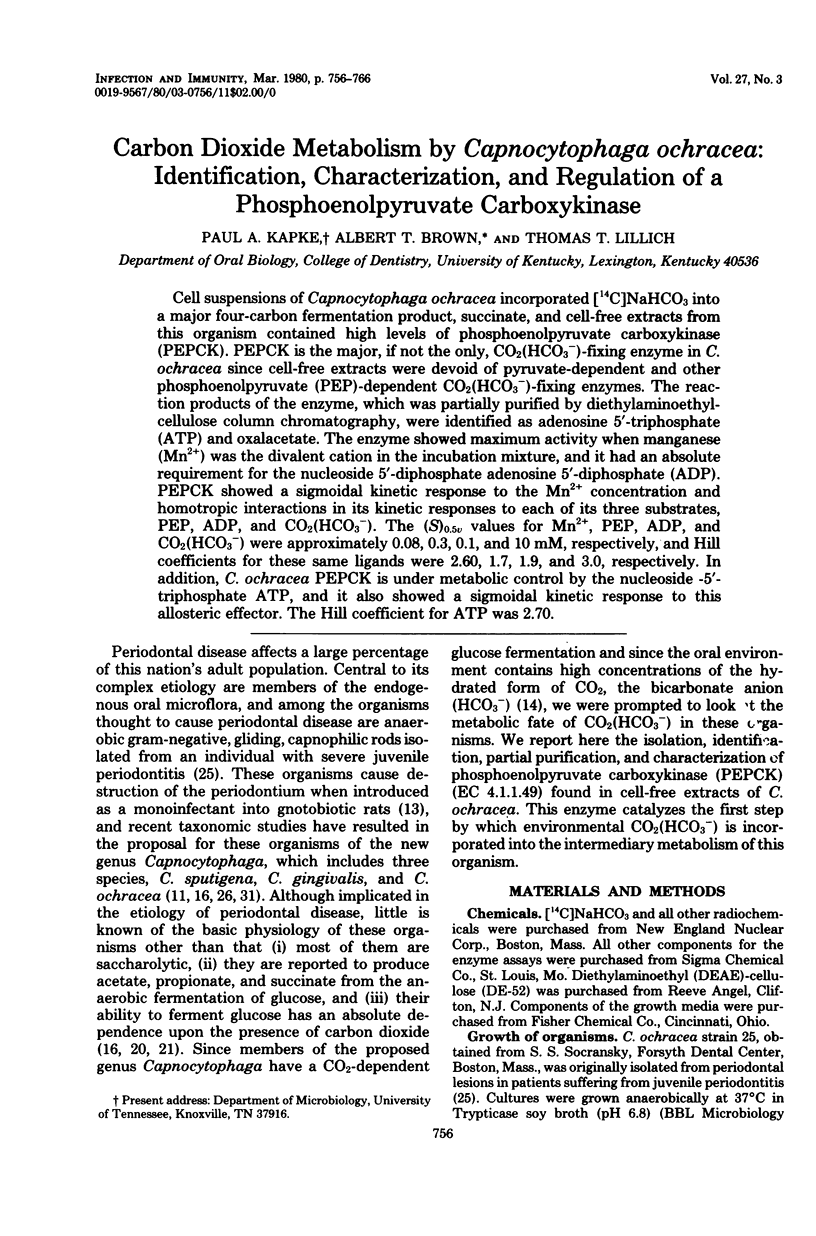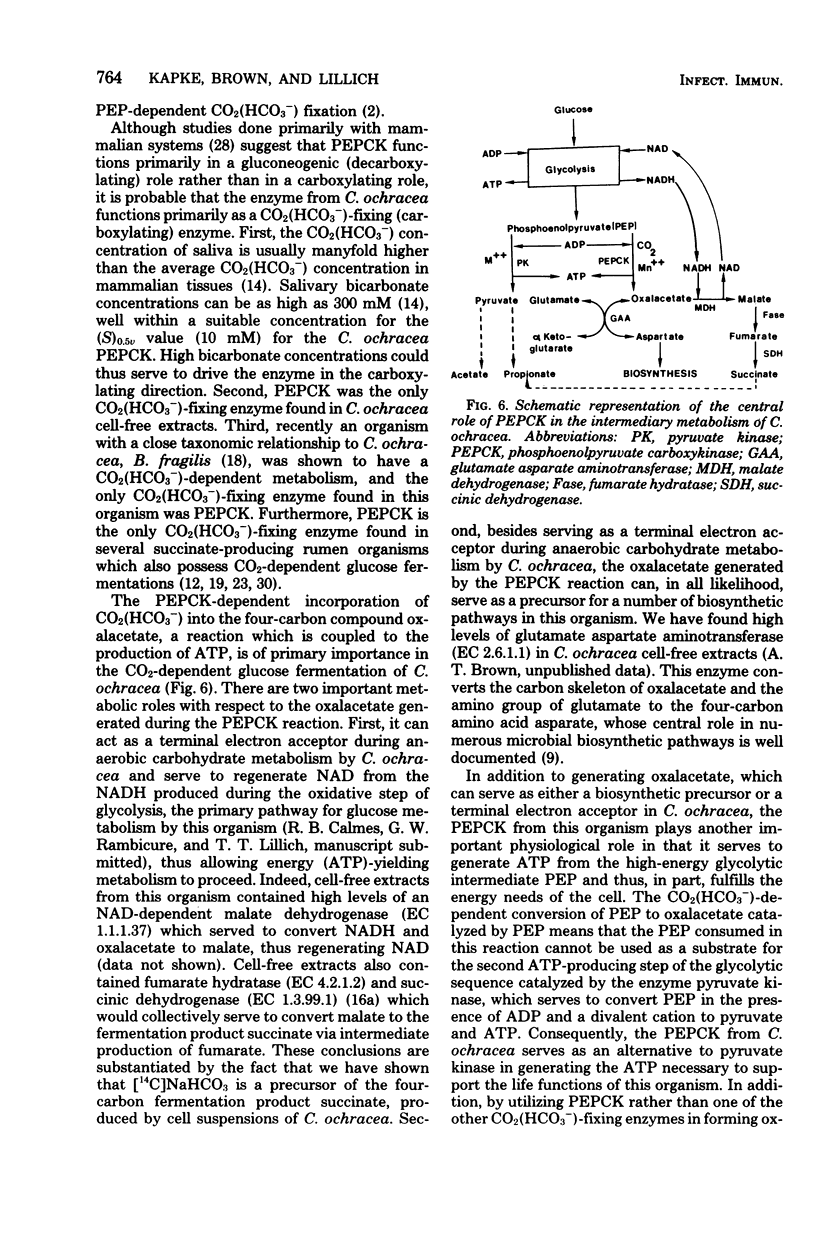Abstract
Cell suspensions of Capnocytophaga ochracea incorporated [14C]NaHCO3 into a major four-carbon fermentation product, succinate, and cell-free extracts from this organism contained high levels of phosphoenolpyruvate carboxykinase (PEPCK). PEPCK is the major, if not the only, CO2(HCO-3)-fixing enzyme in C. ochracea since cell-free extracts were devoid of pyruvate-dependent and other phosphoenolpyruvate (PEP)-dependent CO2(HCO-3)-fixing enzymes. The reaction products of the enzyme, which was partially purified by diethylaminoethylcellulose column chromatography, were identified as adenosine 5'-triphosphate (ATP) and oxalacetate. The enzyme showed maximum activity when manganese (Mn2+) was the divalent cation in the incubation mixture, and it had an absolute requirement for the nucleoside 5-'diphosphate adenosine 5'-diphosphate (ADP). PEPCK showed a sigmoidal kinetic response to the Mn2+ concentration and homotropic interactions in its kinetic responses to each of its three substrates PEP, ADP, and CO2(HCO-3). The (S)0.5v values for Mn2+, PEP, ADP, and CO2(CHO-3) were approximately 0.08, 0.3, 0.1, and 10 mM, respectively, and Hill coefficients for these same ligands were 2.60, 1.7, 1.9, and 3.0, respectively. In addition, C. ochracea PEPCK is under metabolic control by the nucleoside -5'-triphosphate ATP, and it also showed a sigmoidal kinetic response to this allosteric effector. The Hill coefficient for ATP was 2.70.
Full text
PDF










Selected References
These references are in PubMed. This may not be the complete list of references from this article.
- ANDERSON R. L., ORDAL E. J. CO2-dependent fermentation of glucose by Cytophaga succinicans. J Bacteriol. 1961 Jan;81:139–146. doi: 10.1128/jb.81.1.139-146.1961. [DOI] [PMC free article] [PubMed] [Google Scholar]
- Brown A. T., Christian C. P., Eifert R. L. Purification, characterization, and regulation of a nicotinamide adenine dinucleotide-dependent lactate dehydrogenase from Actinomyces viscosus. J Bacteriol. 1975 Jun;122(3):1126–1135. doi: 10.1128/jb.122.3.1126-1135.1975. [DOI] [PMC free article] [PubMed] [Google Scholar]
- Brown A. T., Christian C. P. Regulation of lactate dehydrogenase activity in Actinomyces viscosus by adenosine-5'-triphosphate. Arch Oral Biol. 1974 Jun;19(6):481–484. doi: 10.1016/0003-9969(74)90156-3. [DOI] [PubMed] [Google Scholar]
- Brown A. T., Wittenberger C. L. Fructose-1,6-diphosphate-dependent lactate dehydrogenase from a cariogenic streptococcus: purification and regulatory properties. J Bacteriol. 1972 May;110(2):604–615. doi: 10.1128/jb.110.2.604-615.1972. [DOI] [PMC free article] [PubMed] [Google Scholar]
- Calmes R., Brown A. T. Regulation of lactose catabolism in Streptococcus mutans: purification and regulatory properties of phospho-beta-galactosidase. Infect Immun. 1979 Jan;23(1):68–79. doi: 10.1128/iai.23.1.68-79.1979. [DOI] [PMC free article] [PubMed] [Google Scholar]
- Holt S. C., Leadbetter E. R., Socransky S. S. Capnocytophaga: new genus of gram-negative gliding bacteria. II. Morphology and ultrastructure. Arch Microbiol. 1979 Jul;122(1):17–27. doi: 10.1007/BF00408041. [DOI] [PubMed] [Google Scholar]
- Irving J. T., Newman M. G., Socransky S. S., Heely J. D. Histological changes in experimental periodontal disease in rats mono-infected with a gram-negative organism. Arch Oral Biol. 1975 Mar;20(3):219–220. doi: 10.1016/0003-9969(75)90013-8. [DOI] [PubMed] [Google Scholar]
- LOWRY O. H., ROSEBROUGH N. J., FARR A. L., RANDALL R. J. Protein measurement with the Folin phenol reagent. J Biol Chem. 1951 Nov;193(1):265–275. [PubMed] [Google Scholar]
- Leadbetter E. R., Holt S. C., Socransky S. S. Capnocytophaga: new genus of gram-negative gliding bacteria. I. General characteristics, taxonomic considerations and significance. Arch Microbiol. 1979 Jul;122(1):9–16. doi: 10.1007/BF00408040. [DOI] [PubMed] [Google Scholar]
- Lillich T. T., Calmes R. Cytochromes and dehydrogenases in membranes of a new human periodontal bacterial pathogen, Capnocytophaga ochracea. Arch Oral Biol. 1979;24(9):699–702. doi: 10.1016/0003-9969(79)90120-1. [DOI] [PubMed] [Google Scholar]
- Macy J. M., Ljungdahl L. G., Gottschalk G. Pathway of succinate and propionate formation in Bacteroides fragilis. J Bacteriol. 1978 Apr;134(1):84–91. doi: 10.1128/jb.134.1.84-91.1978. [DOI] [PMC free article] [PubMed] [Google Scholar]
- Miller T. L. The pathway of formation of acetate and succinate from pyruvate by Bacteroides succinogenes. Arch Microbiol. 1978 May 30;117(2):145–152. doi: 10.1007/BF00402302. [DOI] [PubMed] [Google Scholar]
- Newman M. G., Socransky S. S. Predominant cultivable microbiota in periodontosis. J Periodontal Res. 1977 Mar;12(2):120–128. doi: 10.1111/j.1600-0765.1977.tb00114.x. [DOI] [PubMed] [Google Scholar]
- Newman M. G., Socransky S. S., Savitt E. D., Propas D. A., Crawford A. Studies of the microbiology of periodontosis. J Periodontol. 1976 Jul;47(7):373–379. doi: 10.1902/jop.1976.47.7.373. [DOI] [PubMed] [Google Scholar]
- Repaske R., Clayton M. A. Control of Escherichia coli growth by CO2. J Bacteriol. 1978 Sep;135(3):1162–1164. doi: 10.1128/jb.135.3.1162-1164.1978. [DOI] [PMC free article] [PubMed] [Google Scholar]
- Socransky S. S., Holt S. C., Leadbetter E. R., Tanner A. C., Savitt E., Hammond B. F. Capnocytophaga: new genus of gram-negative gliding bacteria. III. Physiological characterization. Arch Microbiol. 1979 Jul;122(1):29–33. doi: 10.1007/BF00408042. [DOI] [PubMed] [Google Scholar]
- Socransky S. S. Microbiology of periodontal disease -- present status and future considerations. J Periodontol. 1977 Sep;48(9):497–504. doi: 10.1902/jop.1977.48.9.497. [DOI] [PubMed] [Google Scholar]
- Stadtman E. R. Allosteric regulation of enzyme activity. Adv Enzymol Relat Areas Mol Biol. 1966;28:41–154. doi: 10.1002/9780470122730.ch2. [DOI] [PubMed] [Google Scholar]
- Valley G., Rettger L. F. THE INFLUENCE OF CARBON DIOXIDE ON BACTERIA. J Bacteriol. 1927 Aug;14(2):101–137. doi: 10.1128/jb.14.2.101-137.1927. [DOI] [PMC free article] [PubMed] [Google Scholar]
- Williams B. L., Hammond B. F. Capnocytophaga: new genus of gram-negative gliding bacteria. IV. DNA base composition and sequence homology. Arch Microbiol. 1979 Jul;122(1):35–39. doi: 10.1007/BF00408043. [DOI] [PubMed] [Google Scholar]
- van Gylswyk N. O. Oxaloacetate Synthesis in Butyrivibrio fibrisolvens. Appl Environ Microbiol. 1979 Jun;37(6):1245–1247. doi: 10.1128/aem.37.6.1245-1247.1979. [DOI] [PMC free article] [PubMed] [Google Scholar]


